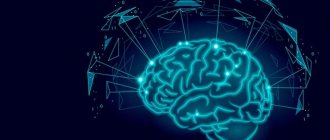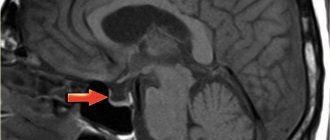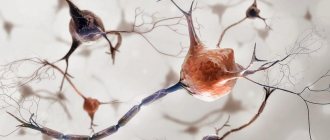general characteristics
Emotions are mental states that reflect a person’s attitude to current events, to people and to himself.
Emotional reactions consist of three components: a feeling of experience, changes in physiological processes and the appearance of external expressive complexes. In other words, a person feels an emotion (joy, anger, fear, sadness), experiences changes in the functioning of the body (sweating, heartbeat) and expresses his state with the help of facial expressions and gestures. Emotional states become pathological when their duration, intensity and content do not correspond to the situation and bring physical and psychological discomfort. Psycho-emotional disorders are characterized by unreasonable and inadequate affect, do not fit into the usual time frame, interfere with the performance of social functions, are perceived as painful or are not recognized by the person himself.
Development mechanism
In psychology, there are two groups of factors contributing to the development of psycho-emotional disorders: internal conditions and external influences. Internal conditions include features of the cognitive sphere: thoughts, ideas, fantasies. A negative assessment of events provokes negative emotions. Another group of internal factors are the psychophysiological characteristics of the body. The biological basis of emotions is the neurohumoral processes of the limbic and diencephalic systems of the brain, the exchange of serotonin, adrenaline, norepinephrine, and dopamine. An imbalance of these substances leads to the development of affective disorders.
Reactions to external environmental conditions can be innate and conditioned. Genetically embedded ways of responding - fear, aggression - are the basis for the formation of more complex emotional and behavioral patterns. During life, the development of affective disorders is facilitated by the processes of experiencing and consolidating traumatic experiences. Repetition or partial similarity of current events with past ones that caused negative experiences becomes the cause of psycho-emotional disorders.
Violation of the emotional-volitional sphere
General information
For normal life activity and development in society, the emotional-volitional sphere of the individual is of great importance.
Emotions and feelings play an important role in human life. will is responsible for the ability that manifests itself during the regulation of its activities. From birth, a person does not possess it, since, basically, all his actions are based on intuition. As life experience accumulates, volitional actions begin to appear, which become more and more complex. The important thing is that a person not only gets to know the world, but also tries to somehow adapt it to himself. This is precisely what volitional actions are, which are very important indicators in life.
You may be interested in: Emotional volitional disorders in children Emotional disorders
The volitional sphere of personality most often manifests itself when various difficulties and trials are encountered along the path of life. The last stage in the formation of will is the actions that must be taken to overcome external and internal obstacles. If we talk about history, volitional decisions at different times were formed thanks to certain work activities.
What diseases cause a violation of the emotional-volitional sphere :
- Schizophrenia
- Manic syndrome
- Depressive syndrome
- Obsessive-phobic syndrome
- Psychopathy
- Alcoholism
- Addiction
External stimuli include certain social conditions, and internal stimuli include heredity. Development occurs from early childhood through adolescence.
Characteristics of the volitional sphere of personality
Volitional actions can be divided into two groups:
- Simple actions (do not require the expenditure of certain forces and additional organization).
- Complex actions (require a certain concentration, persistence and skill).
In order to understand the essence of such actions, it is necessary to understand the structure. An act of will consists of the following elements:
- pulse;
- motive;
- method and means of activity;
- decision-making;
- implementation of the decision.
Violations of the emotional-volitional sphere
Hyperbulia , a general increase in will and drives, affecting all the basic drives of a person. For example, an increase in appetite leads to the fact that patients, while in the department, immediately eat the food brought to them. Hyperbulia is a characteristic manifestation of manic syndrome.
Hypobulia is characterized by a general decrease in will and drives. Patients do not feel the need to communicate, are burdened by the presence of strangers and the need to maintain a conversation, and ask to be left alone. Patients are immersed in a world of their own suffering and cannot take care of loved ones.
Abulia is a disorder limited to a sharp decrease in willpower. Abulia is a persistent negative disorder; together with apathy, it forms a single apathetic-abulia syndrome, characteristic of the final conditions of schizophrenia.
Obsessive (obsessive) attraction involves the emergence of desires that the patient can control in accordance with the situation. Refusal to satisfy an instinct gives rise to strong feelings in the patient, and thoughts of an unsatisfied need constantly persist. Thus, a person with an obsessive fear of contamination will restrain the urge to wash his hands for a short time, but will definitely wash them thoroughly when no one is looking at him, because all the time he endures, he constantly thinks painfully about his need. Obsessive drives are included in the structure of obsessive-phobic syndrome.
Compulsive attraction is a very powerful feeling because it is comparable in strength to instincts. The pathological need occupies such a dominant position that a person quickly stops the internal struggle and satisfies his desire, even if this is associated with gross antisocial actions and the possibility of subsequent punishment.
Classification
Emotional disorders can be independent disorders or components of other mental illnesses. Pathological intensification of emotions is manifested by an increase in their intensity while maintaining adequate content. This group of disorders includes:
- Depression.
The structure of depressive states is dominated by low mood and depression. Patients feel anxiety and a feeling of inferiority. They perceive everyday difficulties as insurmountable and provoke crying, despondency, and reluctance to do anything. - Mania.
Manic states are manifested by elevated mood, accelerated rate of mental activity, and increased physical activity. A person becomes hyperactive, fussy, strives for achievements, to learn new things, but he lacks concentration and focus. - Euphoria.
In euphoria, people are dominated by carelessness, elevated mood, and infantility. Critical abilities and serious attitude to situations decrease. Passivity and excessive complacency do not allow you to perform daily duties.
Another option for psycho-emotional disorders is weakening of emotions. Regardless of the events taking place - joyful, sad, provoking aggression - people remain indifferent or experience weak feelings that do not correspond to the significance of the situation. Examples of such disorders:
- Emotional flattening.
With some mental illnesses, for example, with schizophrenia, emotions become impoverished - they become monotonous, primitive, and weakly expressed. In severe cases, only some manifestation of dissatisfaction in situations of discomfort remains. Other events - meetings with relatives, the loss of a loved one - do not evoke any emotions. - Apathy.
A state of apathy is typical for patients with depression. There is a general decrease in all emotional reactions. The patient is indifferent to what is happening, unable to experience joy, sadness, fear, anger. Often apathy is combined with a decrease in motor activity and abulia - pathological lack of will, the inability to begin any action.
When the mobility of emotions is impaired, a person’s ability to control the duration of the experience changes. This is manifested by stuckness, suddenness, or rapid uncontrollable changes in emotional states. There are several variants of the dynamic aspect disorder:
- Emotional lability.
With affective lability, emotions arise easily, quickly replace each other, and depend on fleeting external events or random memories. Such conditions are considered normal in early childhood, when a child’s tears suddenly give way to laughter, but in adults they are a sign of emotional disturbance. - Explosiveness.
This term refers to emotional explosiveness. After a period of calm, a person suddenly demonstrates anger, irritation, anger, and then just as quickly returns to a state of balance. During explosive outbreaks, aggression and provocation of conflicts are possible. - Inertia.
Synonyms for inertia are stuckness, stiffness. Such people experience one emotion for a long time, cannot be distracted and change it at will, and are in a state of irritability, melancholy, and anger.
The most striking psycho-emotional disorders are disturbances of adequacy. Inappropriate emotional manifestations are classified as pathological according to the content criterion: what a person feels has no connection with his thoughts or external events. This group includes:
- Inadequacy.
With emotional inadequacy, a person experiences and demonstrates emotions that are completely inappropriate for the situation. For example, laughter occurs in response to the news of the death of people, outbursts of anger when meeting a loved one (mother, friend). - Ambivalence.
People with schizophrenia often experience ambivalence of experiences - the simultaneous existence of opposing emotions. This condition is difficult for a healthy person to understand. Outwardly, it manifests itself as a constant, unconditional change of joy and melancholy, tenderness and anger, anger and tearful weakness. - Emotional tension.
Inappropriate experiences may include pointless fear, unmotivated anxiety, an inexplicable feeling of anger or dissatisfaction with oneself. In such conditions, people are in emotional tension, but cannot determine what is causing it. Usually they say: “the soul is restless”, “the soul suddenly sinks into the heels.”
Definition of emotions. Theories, types and mechanisms of emotion disorders. Pathogenesis of emotion disorders
Zobkova Anastasia
Definition of emotions. Theories, types and mechanisms of emotion disorders. Pathogenesis of emotion disorders
MDOU "Kindergarten "Beryozka"
R. n. New Burasy
Work on the topic
" Definition of emotions . Theories , types and mechanisms of emotion disorders . Pathogenesis of emotional disturbances ."
Teacher Zobkova A.A.
2021
Introduction
Emotions are closely related to all vital functions of the body. Anokhin (1968)
pointed out that a person’s vital needs are inseparable from
emotional tone . Emotions impart a certain biological quality to his behavior and are a source of activity and satisfaction of needs. Emotions reflect a person’s subjective attitude to the environment and to his personality. Emotional experiences contribute to the formation of personality and its socio-psychological orientation.
There are higher (social)
and lower
(simplest) emotions . The highest emotions are manifested in patriotism, camaraderie, friendship, labor valor, and a sense of duty to the homeland and society. Lower emotions arise as a result of satisfaction or dissatisfaction of a person’s organic needs (hunger, thirst, sexual desire)
.
Emotions can be positive (pleasant)
and negative (unpleasant, strong and weak. A relatively stable
emotional state is called mood.
With various mental illnesses, a disturbance in the emotional state of the patient . This manifests itself in the form of depression, euphoria, dysphoria, weakness, emotional dullness, etc.
The object of the study is human emotions .
The subject is the peculiarities of emotional disturbances .
The purpose of the study is to analyze emotional disturbances .
To achieve this goal, the following tasks must be completed:
1. Describe the “concept of emotion ”
.
2. Consider theories , types and mechanisms of emotional disorders .
3. Study the pathogenesis of emotional disorders .
1 Definition of emotions
Emotions (lat. emovere – excite, excite)
- states associated with assessing the significance for an individual of the factors acting on him.
Specificity. They are expressed, first of all, in the form of direct experiences of satisfaction or dissatisfaction of his current needs. They are one of the main regulators of activity. The main feature of human emotions is that in socio-historical practice a special emotional language , which can be conveyed as some generally accepted description. On this basis, there is, in particular, an emotional response to works of art that have a fairly strict connection to a certain historical era . Types :
• the emotional tone of sensations is the basic form of emotions and represents genetically determined experiences of a hedonic sign that accompany vital impressions, for example, taste, temperature, pain;
• emotions have a pronounced connection with local situations, which was formed during life. Their emergence can occur without the actual action of the situation of their formation, then they act as guidelines for activity;
• feelings, as stable emotional relationships to certain aspects of reality;
• affects are very strong emotional experiences associated with active behavior to resolve an extreme situation.
Emotional tone of sensations (sensual tone of sensations)
- a form of positive
emotions that has no substantive relevance. Accompanies vital sensations, such as taste, temperature, pain. Represents the earliest stage of the development of emotions in phylogeny .
In Gestal psychology, the concept of seduction has a close meaning.
Seduction (experience of seduction - from German Anmutungserlebnis)
- a diffuse
emotional (sensory)
response to perceived or imaginary signs of an object; the occurrence of this phenomenon is due to the activity of the subcortical parts of the brain and the autonomic nervous system.
When analyzing it, the understanding of the dynamics of cognitive processes significantly deepens. This concept was considered as a theoretical construct in the psychology of V. Wundt, and was especially widely used within the framework of Gestalt psychology, in particular by F. Kruger, E. Wartegg.
Negative emotions (lat. negatio - denial and emovere - excite, excite)
- a form
of emotion that subjectively appears as unpleasant experiences.
They lead to the implementation of adaptive behavior aimed at eliminating the source of physical or psychological danger. 2 Theories , types and mechanisms of emotion disorders
Kinds . Within the framework of cognitive psychology and psychotherapy (A. T. Beck, A. Ellis)
their specificity
is determined through certain intellectual actions:
• anger arises when obstacles arise on the way to achieving a goal and serves to awaken the energy required to destroy the obstacle;
• sadness occurs in a situation of loss of a significant object and serves to reduce the level of energy for its further use;
• fear helps to avoid danger or mobilize for an attack;
• contempt supports one's own self-esteem and dominance behavior;
• shyness signals a need for privacy and intimacy;
• the feeling of guilt establishes a subordinate role in the social hierarchy and indicates the possibility of loss of self-esteem;
• disgust results in repulsion of harmful objects.
Feelings are a form of emotions , which includes emotional experiences, which reflect the individual’s stable attitude towards certain objects or processes in the surrounding world.
Asthenic feelings (Greek asthenes - weak)
- a form of
emotions in which the leading experiences are depression, despondency, sadness, and non-localized fear. They indicate a refusal to fight difficulties in a situation of increased emotional stress .
Diagnostics. A person’s experience of asthenic feelings can be judged by external signs, for example, he stoops, his breathing slows down, his eyes dim.
Stenic feelings (Greek sthenos - strength)
- positive
emotional states , which are associated with an increase in the level of vital activity and are characterized by the emergence of feelings of excitement, joyful excitement, uplift, and vigor.
At the same time, breathing becomes more frequent, deeper and easier, the work of the heart is activated, and in general the body is physiologically prepared for large expenditures of energy. Mood (mental state)
- a form
of emotions that is characterized by diffuseness, the absence of a clear conscious connection to certain objects or processes, and sufficient stability that allows one to consider mood as a separate indicator of temperament. The main sign of a particular mood is an emotional tone , positive or negative.
Mood is characterized by cyclical changes (rise and fall of mood, but too pronounced jumps may indicate mental ill-being, in particular manic-depressive psychosis. It is believed that mood is an integral characteristic of an individual’s system of activities, which signals the processes of implementation of activities and their consistency with each other The main mental states include vigor, euphoria, fatigue, apathy, depression, alienation, and loss of sense of reality.
Diagnostics. The study of mental states is carried out, as a rule, by methods of observation, surveys, testing, as well as experimental methods based on the reproduction of various situations.
Affect (lat. affectus – emotional excitement, passion)
- a form
of emotion , which is a violent, most often short-term emotion . Occurs in critical conditions with the inability to find a way out of dangerous and unexpected situations. Affect is associated with pronounced motor and organic manifestations, leading to inhibition or disruption of all other mental processes (perception, thinking)
and the implementation of corresponding behavioral reactions. Based on the experienced affects, special affective complexes are formed (fear, anger, which can be triggered, without sufficient awareness of the reasons that caused the reaction, when faced with even individual elements of the situation that initially provoked the affect.
Agitation (lat. agitare – to excite)
-
psychopathological disorder in which affective tension caused by stress (accident, threat to life, time pressure, uncontrollably turns into movement. Characterized by motor restlessness, the need for movement. May be accompanied by a feeling of emptiness in the head, inability to reason and act logically, as well as autonomic disorders such as rapid breathing and heartbeat, sweating, trembling hands, pallor. It also acts as a concomitant phenomenon in many mental illnesses (catatonia, anxious neurosis, active depression, involutional depression, senile decline).
Affective stagnation (lat. affectus - emotional excitement , passion)
(accumulation of affect)
- affective tension that cannot be responded to due to restraint
(external circumstances, upbringing, neurosis)
. The accumulation of affects is subjectively experienced as tension and anxiety. In a given signal situation can be resolved in the form of affective explosion Over a more or less long period of time, an accumulation of insignificant negative
emotions , after which mental discharge occurs in the form of a violent and poorly controlled affective explosion, which is launched for no apparent reason.
But sometimes it can also gradually decrease without any excesses. Theory of emotions V. Wundt's theory of the structure of emotions . V. Wundt identified three dimensions of emotions : pleasure - displeasure, calm - excitement, tension - release.
Criticism. E. B. Titchener showed that these measurements cannot be considered independent factors.
The concept of expressive movements was created by Charles Darwin. This is a theory of the origin of emotions , in which the assumption is formulated that human expressive movements are rudiments of the instinctive actions of a living creature associated with struggle, attack, protection of offspring, etc.
Criticism. This concept cannot explain the wealth of human expressive movements (smiles, suppressed tears)
.
theory was developed simultaneously and independently by W. James and K. G. Lange. This is an explanatory model of the emergence of emotions , which is a vasomotor theory of emotions , in which the leading role was given to the somato-vegetative component. This or that emotion is a sensation caused by changes in a voluntary sphere (external movements)
and involuntary
(cardiac, vascular, secretory activity)
.
Thus, peripheral organic changes were interpreted not as a consequence of the emotional process , but as their cause. The peculiarity of Lange's approach was that he emphasized only the vascular system. In it, emotions were interpreted as subjective formations that arise in response to nervous excitement caused by the state of innervation and the width of the blood vessels of the visceral organs.
Criticism. One of the first to attempt an experimental verification of the James–Lange theory . S. Sherrington, for which he cut the cervical spinal cord and vagus nerves. As a result of this, it was shown that the separation of the visceral nervous system from the central nervous system does not change the general behavior of the animal in response to emotiogenic influence . Subsequently, it was finally refuted by W. B. Cannon (1871–1945, an American physiologist and psychophysiologist. He showed that with emotional arousal, adrenaline is released, which ensures the mobilization of the body for active actions. At the same time, the heartbeat increases and blood sugar levels rise , the pupils dilate, digestion is inhibited.
The biological theory of emotions was developed by P. K. Anokhin. This is a theory of emotions that explains the occurrence of positive (negative)
emotions by the fact that the nervous substrate of emotions is activated at the moment when a coincidence (mismatch)
of the action acceptor is detected, as an afferent model of expected results, on the one hand, and signaling about the actually achieved effect, with another.
The need-information theory was proposed by P. V. Simonov (1964)
.
Here it is postulated that emotion is a reflection by the brain of humans and animals of any current need (its quality and magnitude)
and the likelihood of its satisfaction, which the brain evaluates on the basis of genetic and previously acquired individual experience. The relationship of these variables is presented in the formula:
E = f [P, (In–Is,. ],
where E is emotion ;
P - strength and quality of current need;
(In–Is)
— assessment of the likelihood of need satisfaction based on innate and acquired experience;
In - information about the funds, resources and time predicted to be necessary to satisfy the need,
IS - information about the means, resources and time available to the subject at a given moment in time.
Emotion activation theory (MB Arnold, 1950)
;
Lindsey , 1951)
comes from the older thalamic
theory of U. Cannon and F. Bard, the role of internal brain structures is more emphasized here. Sensory stimuli come from the periphery to the cortex and are evaluated; sensory assessments and patterns of behavior embedded in the thalamus are added there. After this there is a transition to the implementation body. From there comes a return message, which is again evaluated and felt. This theory can explain the sudden awakening of affect observed in the clinic.
Two-component theory S. Schechter postulates that the experience of emotions is caused by a combination of two factors. On the one hand, there must be physiological arousal; on the other, the situation must allow for a meaningful cognitive interpretation of this arousal in terms of emotions . This theory was based on experiments in which subjects were given injections of an stimulant drug.
3 Pathogenesis of emotion disorders
The pathology of emotions can be primary and secondary. Primary pathology is characterized by the occurrence of unaccountable, pointless, causeless, vital, unmotivated, vague , substandard emotional disorders . Secondary emotional pathology is objective , motivated in nature; it is plot-based, reactive, and psychogenic. Primary pathology occurs mainly in organic diseases of the brain with direct damage to the emotional ( accident , traumatic brain injury, progressive paralysis and syphilis of the brain, etc.). For endogenous psychoses (schizophrenia, manic-depressive psychosis, epilepsy, etc.)
primary
emotional pathology is associated with an initial hereditarily determined deficiency, weakness of the emotional . Primary emotional pathology may be observed in somatogenic , infectious and intoxication psychoses. Secondary emotional pathology usually occurs as a reaction to external psychotraumatic factors, as well as as a result of personal processing of pathological products (hallucinatory and delusional experiences, primary pathological emotions, etc. ). Some types of primary pathological emotions (unaccountable fear, melancholy, unmotivated pointless joy, anger, anxiety, etc.) arise in healthy volunteers with electrical stimulation of certain points in the mesencephalic parts of the trunk, globus pallidus, tonsil, septum. The classification of emotional disorders is determined by their modality , coloring: fear, anxiety, depression, affect of bewilderment - confusion, euphoria, ecstasy, mania, dysphoria, delusional mood, etc. And also by their severity and duration (hyperthymia, hypothymia, apathy, mood instability, exacerbation and weakening of lower feelings, one-sided pathological strengthening of individual higher feelings, emotional impoverishment , emotional dullness, etc. ). A separate group in the classification of emotions is parathymia (perversion of emotions , which includes: emotional ambivalence , emotional inadequacy , emotional paradox , affective negativism, etc.
Emotional disorders in childhood are quite diverse and have significant differences from emotional disorders in adults. It should be borne in mind that that reactions of protest, refusal, despair in the form of depression, tearfulness, irritability, whims in most cases are not pathology ... Emotional disorders in children are not of a developed nature, appearing in the form of abortive, rudimentary affective disorders emotional disorders occur in children , as arising as a result of emotional deprivation and frustration (prolonged separation of the child from the mother)
anaclitic depression (Spitz., 1946, night and day fears, fear of loneliness, darkness, affective motor restlessness, reactions of protest or dissatisfaction in young children, nervous skin itching,
emotional and anorexia nervosa , childhood dysphoria. Features of affective pathology in childhood are also short-term, fleeting, erased manifestations of depression, greater than in adults, discrepancy between the cause and severity of emotional reactions , their polymorphism, coexistence of emotional disorders with motor , autonomic, obsessive reactions.
Conclusion
From a phenomenological point of view, an emotion always colors some reflected content, that is, it has an objective reference. On the other hand, emotion is also a psychophysiological mechanism , with the help of which, through the “psychic” level of reflection of reality, under the influence of external influences, the internal environment of the body changes (vascular tone, endocrine reactions, metabolism)
.
But the main function of emotions is evaluation , therefore, two components are always present in its structure - the reflected content of the object and the subjective attitude towards it.
into emotional background (or emotional state )
and
emotional response , which are subject to different patterns, since the first is associated with personal characteristics, and the second is situational in nature. Among the parameters to be taken into account when assessing emotions are the sign, intensity, duration, reactivity, qualitative characteristics and connection with needs, the degree of awareness and the degree of arbitrariness of control. Changes emotional state lead to changes in facial expression (facial expressions, indirect gestures appear (pantomimics, specific shades of intonation and voice timbre appear. Similar changes can be found in the pre-speech period of a child’s life, but with age, the style of presenting emotions . According to some authors, up to 90% of emotional communication occurs at the non-verbal level. Expressions of feelings that appear in certain external manifestations are usually called expression. Mastering it consists of two complementary processes - the ability to recognize shades of expression and the ability to use them to inform about one’s own experiences.
Emotions disorders - a special class of mental disorders associated with difficulties in perceiving and expressing emotions . Symptoms of emotional disorders are numerous and varied. They are of great diagnostic importance in determining the pathology of the emotional sphere itself , as well as in determining the severity of psychopathological syndromes . Symptoms of emotional disorders usually include disturbances in emotional response (acute and inadequately intense emotional reactions to various external events and situations) and symptoms of mood disorders.











